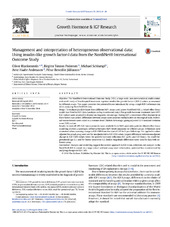| dc.contributor.author | Blankenstein, Oliver | en_US |
| dc.contributor.author | Pedersen, Birgitte Tønnes | en_US |
| dc.contributor.author | Schlumpf, Michael | en_US |
| dc.contributor.author | Andreasen, Arne Haahr | en_US |
| dc.contributor.author | Juliusson, Petur Benedikt | en_US |
| dc.date.accessioned | 2016-03-29T12:12:42Z | |
| dc.date.available | 2016-03-29T12:12:42Z | |
| dc.date.issued | 2014-12-09 | |
| dc.Published | Growth Hormone & IGF Research 2015, 25(1):41-46 | eng |
| dc.identifier.issn | 1532-2238 | |
| dc.identifier.uri | https://hdl.handle.net/1956/11763 | |
| dc.description.abstract | Objective. The NordiNet® International Outcome Study (IOS), a large-scale, non-interventional, multi-centre, real-world study of Norditropin® treatment, registers insulin-like growth factor-I (IGF-I) values, as measured by different assays. This paper considers the potential biases introduced by using a single IGF-I reference data set in analysing NordiNet® IOS data. Design. To evaluate possible biases from different IGF-I assays used across NordiNet® IOS, a mixed-effect linear model was fitted to IGF-I data (analyses on log-transformed data). Pre-growth hormone treatment (pre-GHT) IGF-I values were assumed to depend on diagnosis, sex and age. During GHT, a treatment-effect dependent on these factors was added. Differences between assays were assumed multiplicative on the original scale. Individual measurements were scaled to a common level (Nichols Advantage) giving adjusted IGF-I standard deviation score (SDS) values. Results. In total, 49 495 IGF-I measurements were available from 9481 paediatric patients. Mixed-effect linear modelling showed a systematic difference between IGF-I levels measured by different assays. Differences were minimised when assessing change in IGF-I SDS from the start of GHT to 1-year follow-up. This applied to values adjusted for actual-assay used and for unadjusted delta IGF-I SDS values. Largest differences between unadjusted change in IGF-I SDS values were: for growth hormone deficiency 0.1 (girls) and 0.3 (boys); for small-for-gestational age 0.1; and for Turner syndrome 0.2. Similar magnitude differences were seen for data with unknown assay. Conclusions. Analysis and modelling suggest the current approach to IGF-I data collection and analyses in the NordiNet® IOS is sound: in a large cohort without assay-used information, potential bias is minimised by analysing changes in IGF-I SDS. | en_US |
| dc.language.iso | eng | eng |
| dc.publisher | Elsevier Ltd. | eng |
| dc.rights | Attribution CC BY-NC-ND 3.0 | eng |
| dc.rights.uri | http://creativecommons.org/licenses/by-nc-nd/3.0 | eng |
| dc.subject | Growth hormone | eng |
| dc.subject | Growth hormone therapy | eng |
| dc.subject | IGF-I | eng |
| dc.subject | Norditropin® | eng |
| dc.subject | Pharmacoepidemiology | eng |
| dc.subject | Assay | eng |
| dc.title | Management and interpretation of heterogeneous observational data: Using insulin-like growth factor-I data from the NordiNet® International Outcome Study | en_US |
| dc.type | Peer reviewed | |
| dc.type | Journal article | |
| dc.date.updated | 2015-12-29T13:58:23Z | |
| dc.description.version | publishedVersion | en_US |
| dc.rights.holder | Copyright 2014 The Authors | |
| dc.identifier.doi | https://doi.org/10.1016/j.ghir.2014.12.001 | |
| dc.identifier.cristin | 1240172 | |
| dc.subject.nsi | VDP::Medisinske fag: 700::Helsefag: 800::Epidemiologi medisinsk og odontologisk statistikk: 803 | |
| dc.subject.nsi | VDP::Midical sciences: 700::Health sciences: 800::Epidemiology, medical and dental statistics: 803 | |
| dc.subject.nsi | VDP::Medisinske Fag: 700 | en_US |

